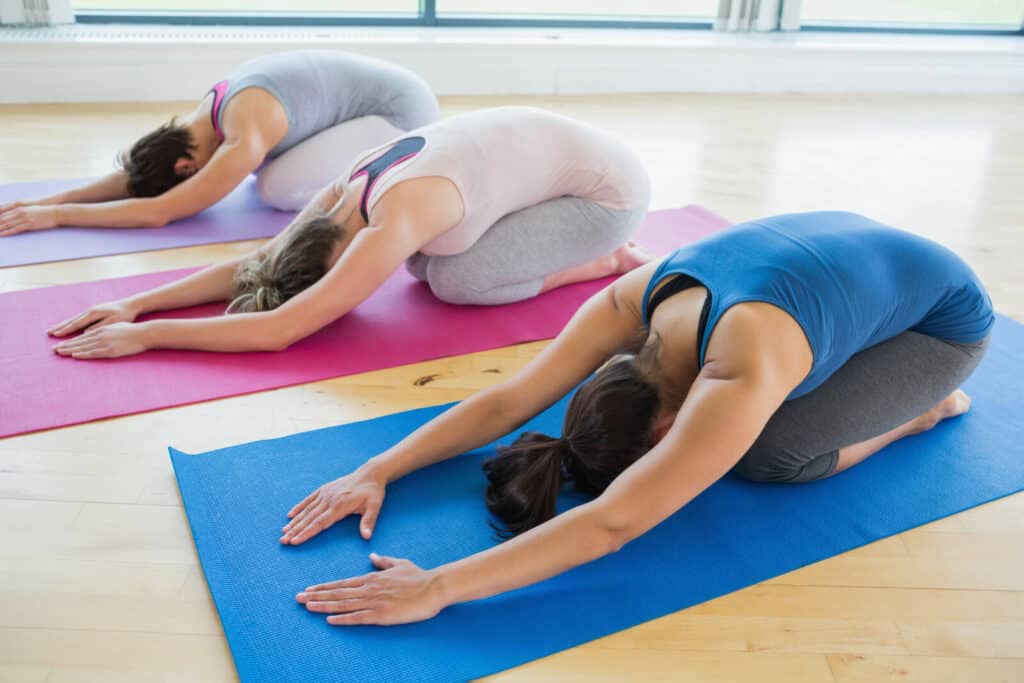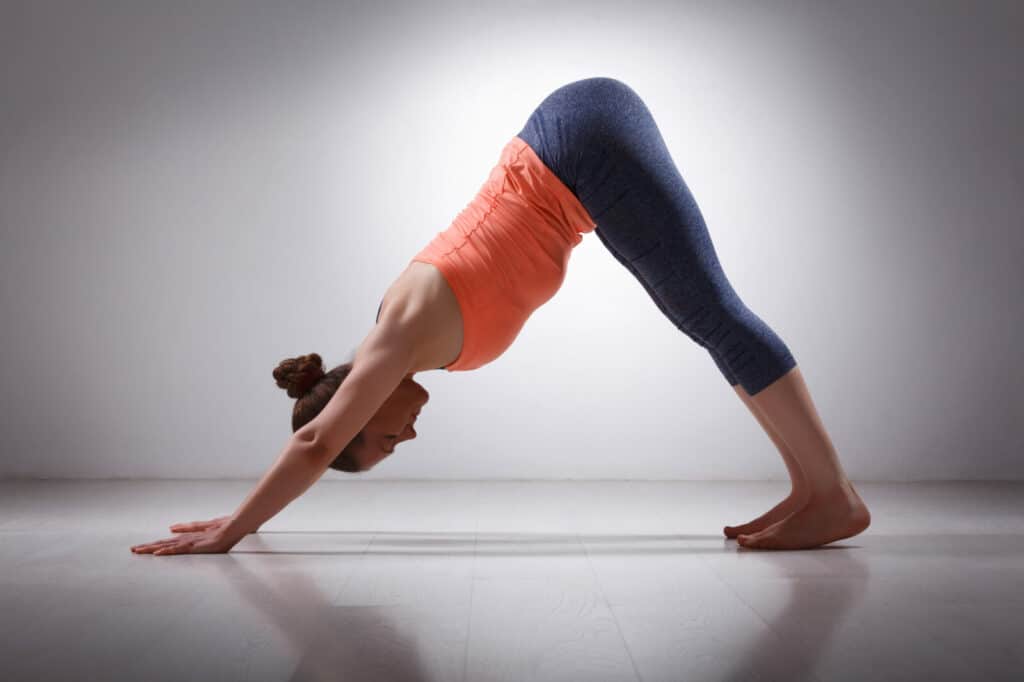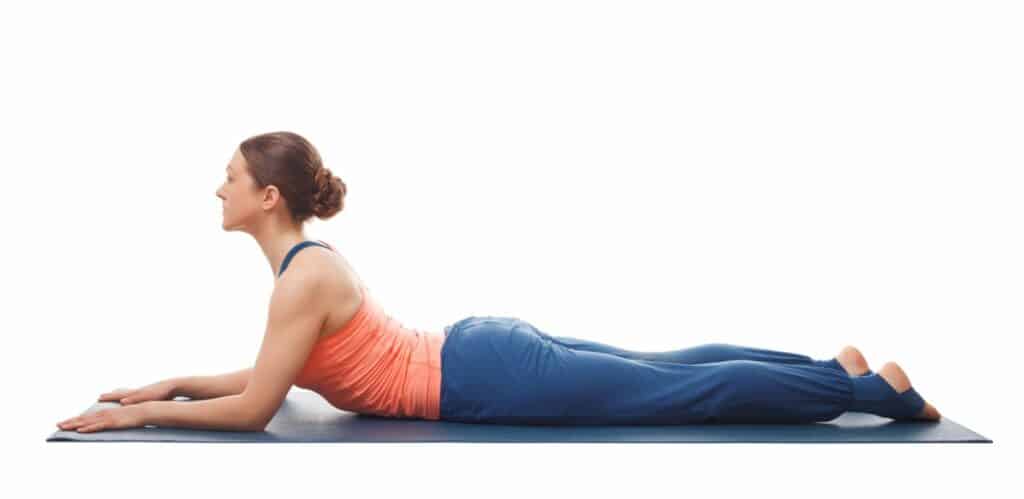Lower back pain can be really annoying. But more disturbing fact is that continuous chronic pain in the lower back can lead to serious spine issues if you don’t do anything to relieve it.
These 5 simple and safe yoga postures will help you ease the pain in your lower back:
- Child’s Pose
- Cat-Cow
- Sphinx Pose
- Savasana with props
- Downward facing dog
Add these exercises to your daily workout or do them as a separate routine. You’ll need only 20-30 minutes.
Below we have also included asanas breakdown and safety tips for those who experience lower back pain or discomfort.
What Is the Best Exercise for Lower Back Pain?
Yoga for the lower back aims to improve your posture by gentle stretching of muscles and adding more flexibility to your hips and legs. In this way, you’ll feel relief from tension in your lower back and improve the load distribution on your spine.
Why Yoga Is Good? 5 Unique Yoga Benefits Proved with Your Anatomy
NOTE: yoga practice is not recommended in periods of sharp pain. If you experience acute pain in your lower back for 72 hours in a row, have disc issues or back injury you know about, you should visit your physical therapist before you start exercising.
We’ve gathered some basic yoga positions that can help you relieve aches in the lower back below.
Child’s Pose

How to:
- Put your knees on the mat (approximately hip-width). With an exhale, settle your pelvis on the feet, and fold down, pressing your torso to your thighs.
- Relax the lower back and shoulders; let your arms rest on the mat behind you, palms up.
- Try to put your forehead on the mat. If that’s difficult or your pelvis goes up – place your arms under the forehead or use a block.
- Relax into the pose for several breathing cycles.
Cat-Cow


How to:
- Start in a table-top position (hands under your shoulders, knees under thighs).
- As you inhale, tuck your tailbone a little, scoop your spine in, lift your head and press your shoulder blades a bit – Cow pose. Try to lengthen your neck and push ribs away from the tailbone. Hold for several breath cycles.
- Press your spine up and arch your back in the Cat pose. Push the floor, actively rounding the spine between shoulder blades. Repeat the sequence transiting smoothly from Cat to Cow.
Downward-Facing Dog

- You can start it from a Child’s pose, all-fours, or Upward facing dog (depending on the sequences you like to practice).
- If you are in the Child’s pose, press your hands to the floor in front of you and lift your pelvis, stretching the spine. Concentrate on relaxing your hamstrings and reaching your heels to the floor. If you feel too much stiffness in your legs – bend them a little and push your butt up.
- Hold for 5 -8 breathe cycles.
Sphinx Pose

- Lay down on your belly, legs straight, tuck your tailbone to make your lower back muscles unengaged into the pose.
- Put your elbows under your shoulders and press your forearms to the ground. Inhale and lift your chest. Keep your legs and thighs on the floor.
- Hold for 5 seconds and slowly lay down on the mat. Relax the whole body. Increase the hold gradually.
Reasons for Lower Back Pain
The lower back is the most massive and heavily loaded part of your spine. Statistics says that around 80% of USA citizens have experienced lower back pain in their life.
Orthopedic surgeons and spine specialists define two types of back pain: acute and chronic. Acute back pain can last from few days to few weeks, chronic – above 3 months.
Lower back pain is considered a symptom, not a medical diagnosis. Still, before you start any treatment for it, it’s an excellent idea to identify the underlying cause, which is not always obvious in the case of lower back pain. The usual unspecific causes of acute lower back pain are:
Strains and Sprains
Strains affect only muscles when you stretch them above their normal length or overload them with excess activity.
Sprains – are overstretching in the joints. Typical situations when these can hit you are lifting heavy objects, poor posture, sudden moves (for example, fall), sports injuries, and a sedentary lifestyle.
Disk Damage
Disks in your spine work as a cushion between your bones (vertebrae). With age, the disk’s soft tissue can wear down, and bones start pressing on a nerve. A doctor can diagnose such a disk condition after a spine X-ray.
Degenerative-Dystrophic Changes
Disorders like arthritis or osteoporosis, caused by wear and tear of the disk tissue. This process can be accelerated by unhealthy lifestyle habits (like smoking), genetic predisposition to such disorders.
How Do You Know If Back Pain Is Muscle or Disc?
If you feel pain in the lower back when bending forward AND when you return from the forward fold – chances are you have got a disk issue. In the case of strains, your lower back will hurt less when you bend forward and more when you return to the upright position.
Can Emotional Stress Cause Lower Back Pain?
At its core, stress is a body’s reaction to unpleasant thoughts and situations. When you anxious or arguing with your boss at work, your body responds to the problem with physical and chemical processes you may not realize.
Adrenaline and cortisol levels in your blood increase, and that causes tension in your muscles. The areas that are usually prone to stress are the shoulders, neck, and low part of your back. These tight areas are not stretched or massaged with time tension can result in back pain.
How Can I Prevent Lower Back Pain?
Following these simple recommendations can help you reduce the chances to experience lower back pain:
- Maintain a more active lifestyle. Add to your gym training exercises to strengthen and stretch your back or do yoga.
- Reduce the time of sitting during the day. If and while you’re sitting, maintain good posture, avoiding rounding your back.
- Stay away from smoking and other harmful habits.
- Stick to a healthy diet to control your weight
- Use proper lifting techniques in the gym and regular life
Tips to Protect Your Back on the Mat
To keep your lower back safe, stick to basic safety rules:
- Remember to warm up before and cool down after the practice
- Increase the loads gradually
- Work towards solid core muscles to help your spine be supported.
How Do You Strengthen Your Lower Back Muscles?
Bridge, Plank, and Boat pose will help you improve the strength of your core. Just add some of those to your regular practice, and within 2-4 weeks, you’ll see the results.
11 Best Exercises for Upper Butt (Home-Friendly)
Alternatively, you can use this simple 25 minutes sequence for your core:
How Can I Relax My Lower Back?
The best way to relax your lower back is to take the vertical load off it. The fastest way to do this is to lay down on the mat.
In this way, your lower back muscles will be supported by the floor, and you’ll get a faster and deeper relaxation.
Savasana and Supta Padangusthasana I with props can be a lifesaver to relax your lower back fast. Find short video guides for both asanas below:
Savasana (with Props)
Supta Padangusthasana I
Yoga for Lower Back FAQs
Is It OK to Exercise with Lower Back Pain?
It’s crucial to stay aware of your body’s current state during the practice and be receptive to its signals. Pain – is the first signal you should stop doing any asana. So do not try to go over the pain with a deeper stretch. Release the stretch until you feel comfortable again.
What Exercises Should I Avoid With Lower Back Pain?
If you are prone to lower back pain – reduce the postures that include too much or too deep twisting and bending.